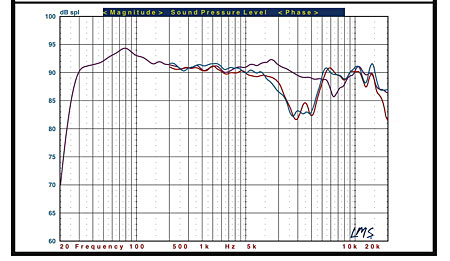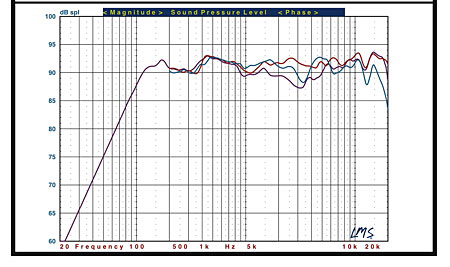Definitive Technology Mythos Super Towers, Gem XL and Ten center channel speaker Measurements
The Mythos Super Tower was measured with its fixed grille in place. The Mythos Ten center channel was measured with its grille removed. The grille had minimum effect on the Ten's high frequency performance, but it roughened the response between 3kHz and 12.5kHz (not shown), with dips (likely due to diffraction) at approximately 3kHz, 6kHz, and 12kHz to a maximum depth of about 3dB.
The impedance of the Mythos Super Tower measured a minimum of 4.4Ω at 354Hz. its on-board subwoofer was tuned to approximately 28Hz. I would rate the speaker's nominal impedance at 7Ω, and together with its sensitivity of 91dB/2.83V/m and benign impedance phase angle it should be an easy load to drive.
The horizontal front averaged response of the Mythos Super Tower is shown in Fig.1 (violet). This is the pseudo-anechoic response averaged over a 30° forward horizontal angle, taken at tweeter height, combined with the nearfield responses of low frequency drivers and the passive radiators.

Fig.1: Definitive Technology Mythos Super Tower, pseudo-anechoic response, off-center in the horizontal plane, at 45° (red) and 60° (blue).
The Tower's response, taken in this manner, has a gradual downward slope from a peak at 80Hz to about 7kHz, at which point it increases by several dB at 11kHz. The latter could explain the brightness that FM noted in some recordings. The bump up at 11kHz may not obvious on good recordings, apart from a little added sparkle, but combine it with a bright recording and it may well call attention to itself. There is also a small rise at about 1.8kHz, which may add a slight presence punch to the sound. The off-axis response tapers off more sharply in this same region before recovering slightly in the low treble.
Despite a slight peak at 80Hz (about +3dB relative to the level at 150Hz, and an odd aberration in a speaker with an active subwoofer, which offers more design control in the low frequencies) the Tower's bass holds up strongly down to just under 25Hz (-10dB) relative to its level at 100Hz.
Fig.2 shows the same averaged horizontal front response (violet), but this time overlaid with the vertical responses taken at +15° (red) and –15° (blue). There's a significant suckout in the vertical off-axis response centered near 3kHz. You'll definitely get the best performance from the Mythos if your ears are close to tweeter height.

Fig.2: Definitive Technology Mythos Super Tower, pseudo-anechoic response at 15° above (red) and 15° below (blue) the tweeter axis.
The center channel Mythos Ten's minimum impedance measured 4.7Ω at 241Hz. I would rate the speaker's nominal impedance at 7Ω. Its sensitivity measured approximately 91dB/2.83V/m. This speaker should be an easy load for any competent amplifier or receiver.
The measured front horizontal response of the Mythos Ten, taken on the tweeter axis and averaged in the same manner as described above for the Mythos Super Tower, is shown in Fig.3 (violet curve). The speaker is tuned to 76Hz. The response rolls off rapidly fin the bass, and the effective lower limit of the response, relative to the output at 100Hz, is 58Hz.

Fig.3: Definitive Technology Mythos Ten, pseudo-anechoic response, off-center in the horizontal plane, at 45° (red) and 60° (blue).
The Ten's wide off-axis performance exhibits the pronounced suckouts that are the inevitable result of a center channel speaker with horizontally configured drivers. With any speaker like this, you'll need to avoid sitting significantly off center if you want to hear the best response and the clearest voice intelligibility. Even at 30 degrees off axis (not shown) the dip centered at 2.5kHz is nearly 20dB down from the on-axis average response at the same frequency.
Fig.4 shows the vertical response of the Mythos Ten at + 15° (red) and –15° (blue), overlaid again with the averaged front horizontal response. Interestingly, the response is actually slightly flatter at a small angle above the tweeter than either below the tweeter or level with it.

Fig.4: Definitive Technology Mythos Ten, pseudo-anechoic response at 15° above (red) and 15° below (blue) the tweeter axis.
Overall, apart from the off-axis performance of the Mythos Ten this is a respectable though not spectacular set of measurements. While the responses of both speakers exhibit some bumps at the frequency extremes, they are, in general, relatively linear through the all-important midrange, particularly the Tower. But try to avoid those off center seats!
Thomas J. Norton
All figures: Violet curve: pseudo-anechoic response on the tweeter axis, averaged across a 30° horizontal window, combined with nearfield responses of the woofers (and, in the Mythos Super Tower, the port). All measurements taken at 1 meter.





























































